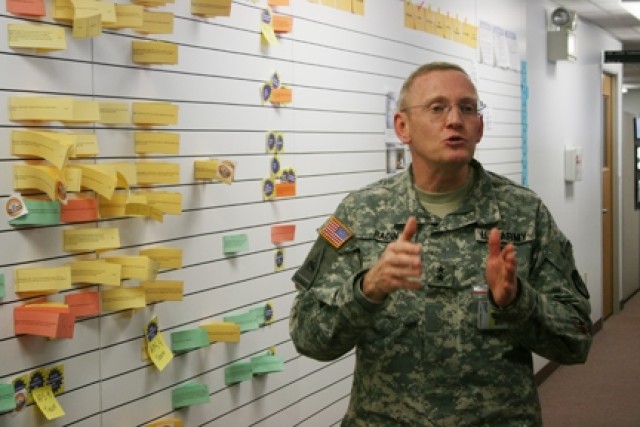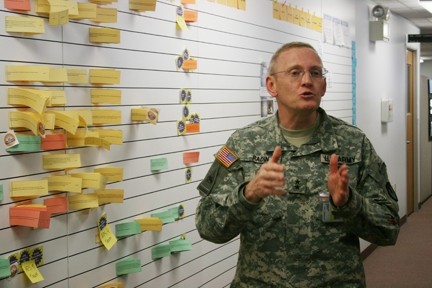If you journey up to the Army Sustainment Command Headquarters' Command Assessment and Continuous Improvement office, you will find a wall that is reminiscent of elementary school, but the content is 21st century management. It is changing the way the ASC is doing business.
The Enterprise Board or E-Board is a high-level picture of the information that is tracked by the CACIO. Information that is gathered by the Enterprise Catalog and Assessment Tool is recorded and is displayed and scrutinized on te board.
"The ECAT is a spreadsheet that categorizes any opportunity or finding in a number of ways across the command," said program analyst Kari Gallagher. "The spreadsheet then allows us to analyze, track trends, look for patterns, and gain an overall picture of the command."
The E-board is nothing more than an enlarged spreadsheet. It provides a friendlier format for looking at information. It presents data in an easy-to-understand table by location and functional area, called "buckets."
Right now you can find many opportunities for improvement on this board. There is a wide variety of sources of information for the board: inspection teams, evaluation teams, staff assistance visits, internal review findings, Lean Six Sigma workshops and ASC Logistics Support and Evaluation team evaluations," Gallagher said.
It allows the commanding general to see an enterprise-wide picture of continuous improvement, scan to see where risks exists, and direct effort to those areas.
"Continuous improvement is the engine that drives this command," said Maj. Gen. Robert M. Radin, commanding general of the U.S. Army Sustainment Command. "We can make strides in continuous improvement by helping each other."
The E-board can help people at all levels in the command. It helps evaluation and inspection teams by portraying a sense of problems and successes discovered at a location or in a particular functional area during other teams' trips, prior to conducting site visits.
The board can supports ASC staff by identifying trends, improvement opportunities, and continuous improvement events in their functional areas, then comparing them to other functional areas throughout ASC. It almost forces a look outside the "stovepipe", promoting cross functional cooperation and collaboration.
It allows brigade commanders to look at the "state of the command" for their area of operation relative to various assessments and continuous improvement initiatives. They can learn about and replicate best practices from other brigades.
A simplistic example of how the E-board can help the command and the Soldier would be if two brigades are having problems with a type of vehicle. The trend can be tracked on the board and a team and be dispatched to look into the problem. The solutions then can be shared with other brigades and cut down time to return the vehicle to a ready status.
"We can identify issues that could be a problem before they become big problems for the Soldier and cut it off," Gallagher said. "Any time we can make a process better, and make it better across the command is a way that we are helping the Soldier in the field.
"This board allows us to focus on improving processes that are in direct support of Soldiers and units," said Director, Command Assessment and Continuous Improvement Office, Jerry DeLaCruz. "That enables us to provide them with the best equipment on time."
Currently, the E-board is in its first stages of development.
"Right now it is just a visual prototype of how we envision the future ECAT," said DeLaCruz. "In the future, the ECAT will reside in software, but we want the ability to visualize a whole board."
The board is not only changing the way ASC is doing business but is also standardizing it as well.
"The board facilitates standardization of best practices across the command," said DeLaCruz. "When we figure out what the new and improved processes are at one location, we then can standardize that as the way of doing business across the command."




Social Sharing